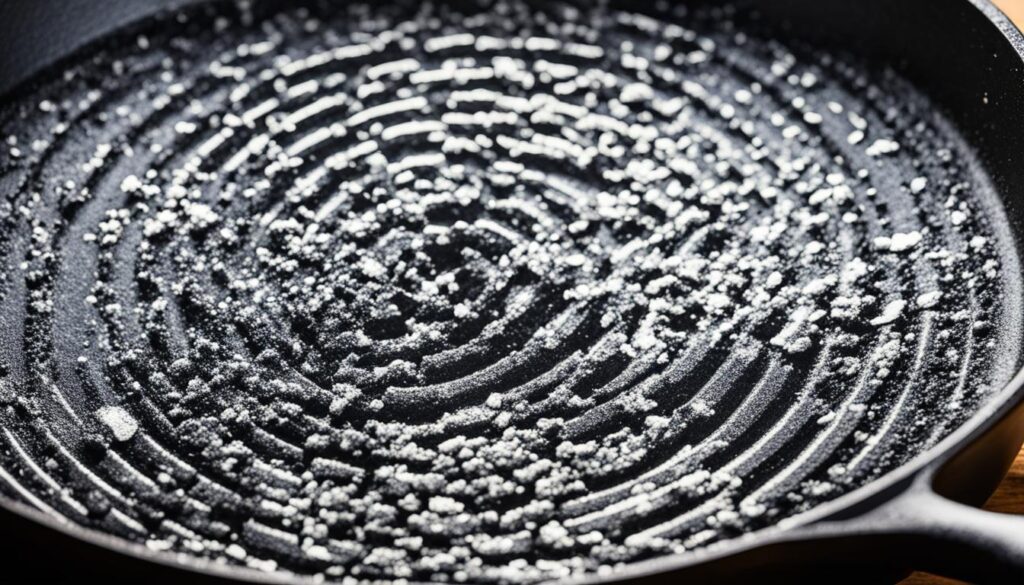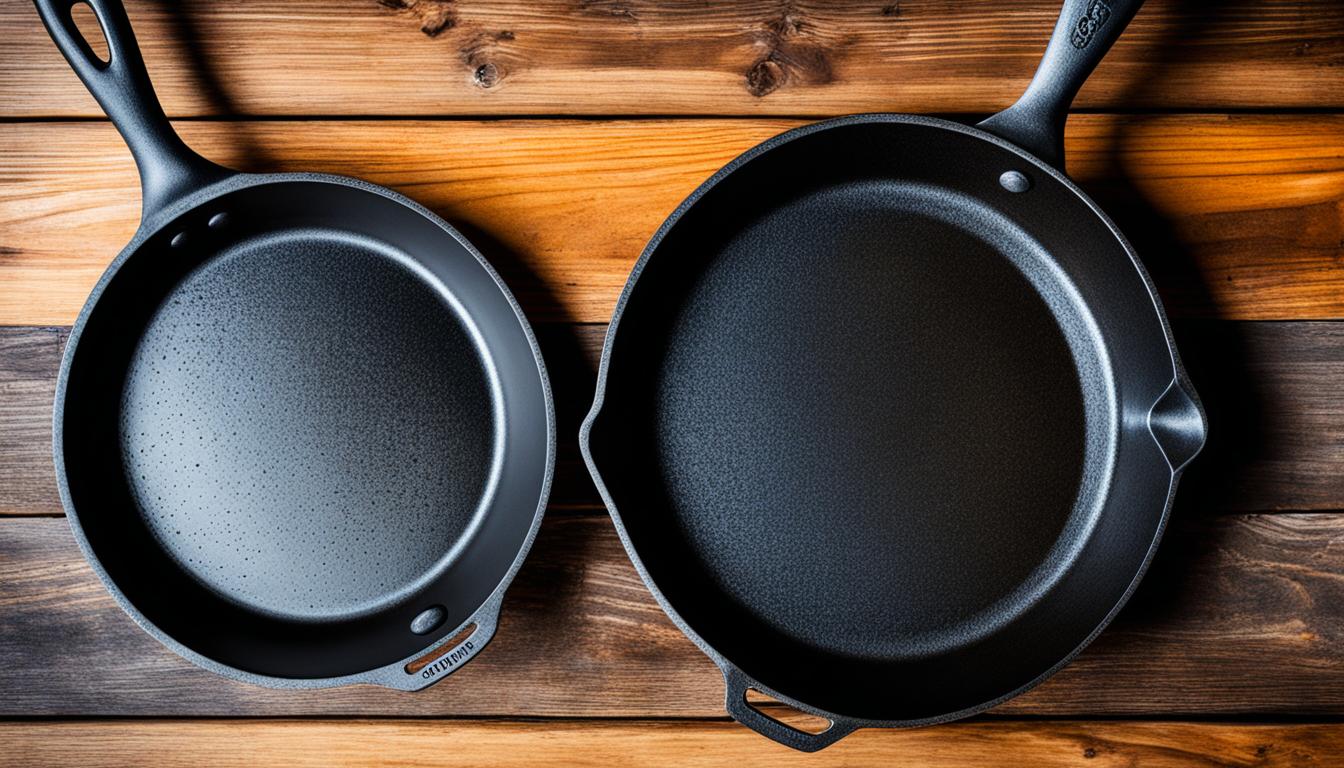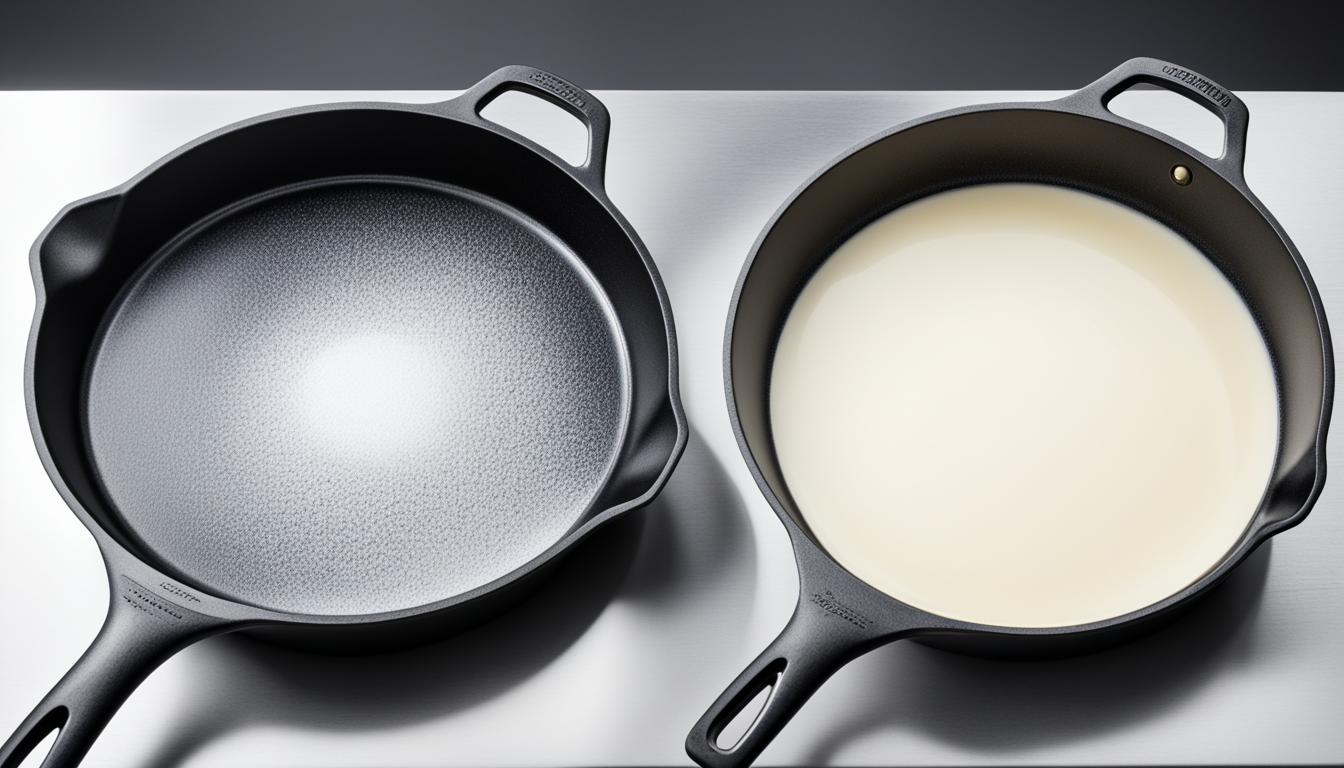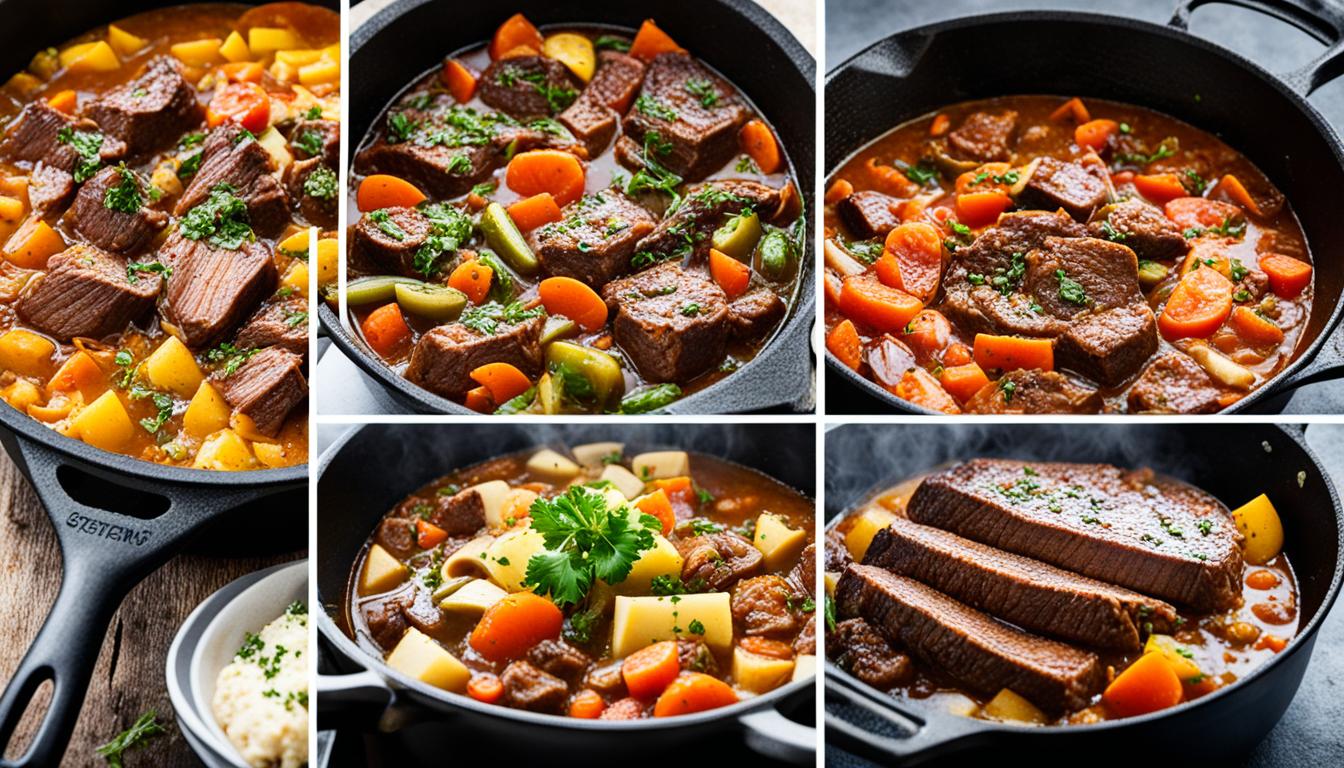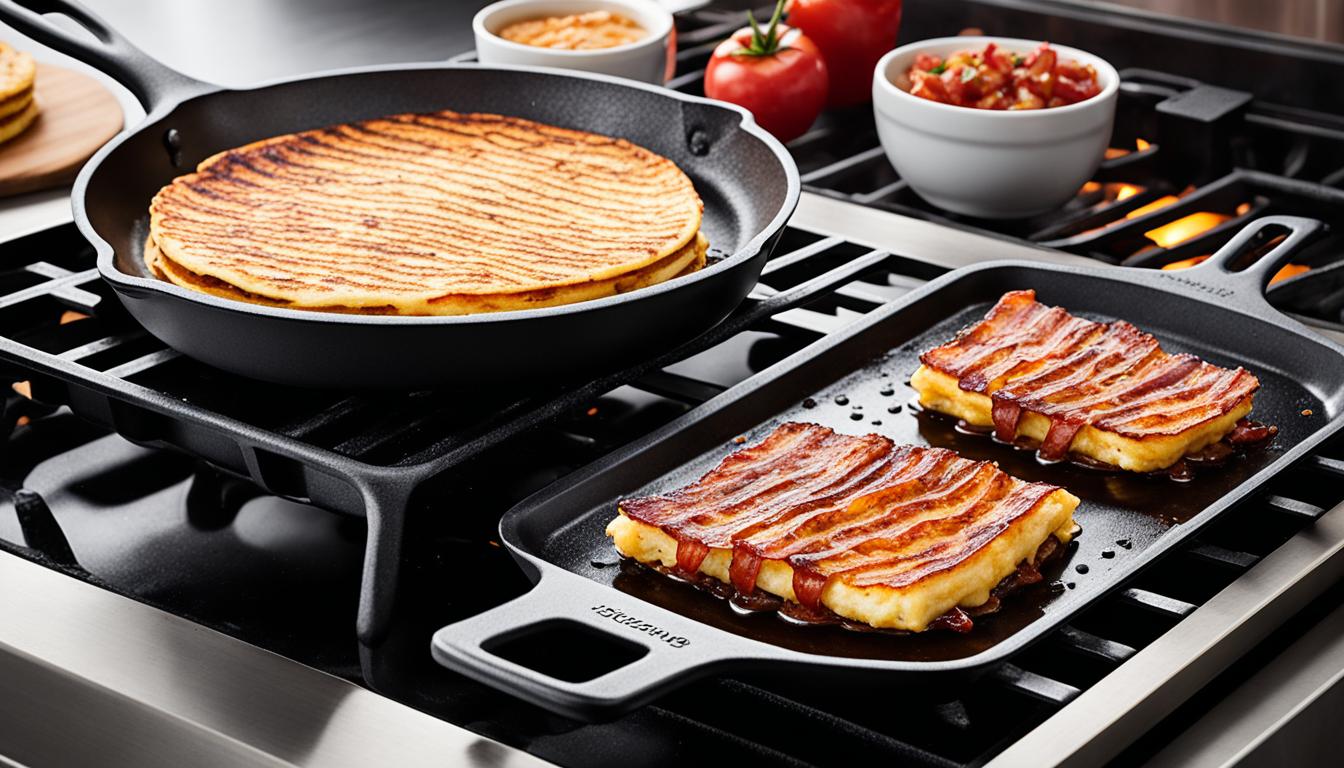Ever wondered what makes cast iron skillets so strong and good at keeping food warm? Cooking fans like me take notice of these qualities. We will look at the magic behind their design.
Cast iron skillets are made from a mix of iron, carbon, and silicon. These materials create a solid piece of cookware. They have an amazing ability to spread heat evenly and keep it for a long time. This is why they’re great for cooking steaks or making deep-dish pizza.
The making of a cast iron skillet is truly interesting. It begins by melting pig iron, steel scraps, and other items in a really hot electric furnace. The temperature reaches over 2,000 degrees Fahrenheit, changing everything into a liquid state. This liquid metal is poured into molds made of sand, giving the skillet its shape.
What’s unique about cast iron is its seasoning. This means the more you cook with your skillet, the better it gets. You’re creating a layer that prevents food from sticking. It also stops the skillet from rusting and lets you use it for a lifetime.
Key Takeaways
- Cast iron skillets are made of an iron alloy including carbon and silicon
- The manufacturing process involves high-temperature melting and sand casting
- Cast iron’s unique composition contributes to excellent heat retention and distribution
- Seasoning builds up over time, improving the skillet’s performance
- The durability of cast iron cookware allows it to last for generations
Table of Contents
- 1 The History of Cast Iron Cookware
- 2 What Is a Cast Iron Skillet Made Of? – Composition of Cast Iron Skillets
- 3 The Manufacturing Process of Cast Iron Skillets
- 4 Unique Properties of Cast Iron Cookware
- 5 Benefits of Cooking with Cast Iron
- 6 Caring for Your Cast Iron Skillet
- 7 Enameled vs. Bare Cast Iron
- 8 Health Considerations of Cast Iron Cooking
The History of Cast Iron Cookware
Cast iron cookware has a long and interesting history that goes back thousands of years. I find it impressive how this ancient kitchen tool has made its way to our modern homes. It has proven its worth over time, adapting with each era and cooking style.
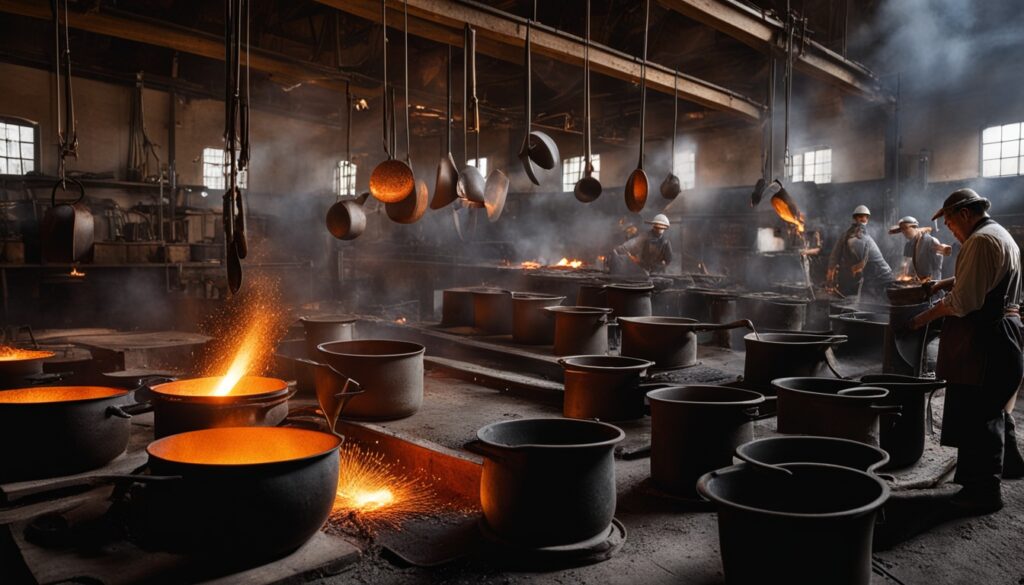
Ancient Origins in Asia
The tale of cast iron cookware starts in ancient China, around 680 B.C. It was there that craftsmen learned to cast iron into sturdy pots and pans. These first creations set the stage for the cast iron cookware we use today.
Evolution in Europe and America
By the 16th century, cast iron had crossed over to Europe, where it was loved for its strength and ability to keep food warm. In the U.S., it became essential for cooking well before the days of modern stoves. Pioneers and settlers found it invaluable in their kitchens.
American companies like Griswold and Wagner began making cast iron cookware on a larger scale in the late 19th century. They set a high standard for quality, marking a turning point in the cookware’s history.
Rise and Fall in the 20th Century
Cast iron reached its peak in popularity during the early 1900s, known for being long-lasting and versatile. However, its fame waned with the advent of Teflon-coated aluminum pots and pans in the 1960s and 1970s.
But things are changing yet again. Thanks to famous chefs and cooking shows, people are getting back to cast iron. They are relearning its charms, like even heat distribution and the non-stick surface it builds over time.
Recipes such as this Chinese Chicken Cabbage Stir Fry highlight why cast iron remains so beloved. It not only makes meals delicious but also stands the test of time in our kitchens.
| Era | Key Developments |
|---|---|
| 680 B.C. | First cast iron vessels in China |
| 16th Century | Introduction to Europe |
| 19th Century | Mass production in America begins |
| Early 20th Century | Peak popularity in households |
| 1960s-1970s | Decline due to new cookware types |
| Present Day | Resurgence in popularity |
What Is a Cast Iron Skillet Made Of? – Composition of Cast Iron Skillets
Cast iron skillets have always amazed me. They are both strong and versatile. Understanding their iron makeup helps us appreciate their special abilities. Now, We will look at the elements that go into making these wonderful cooking tools.
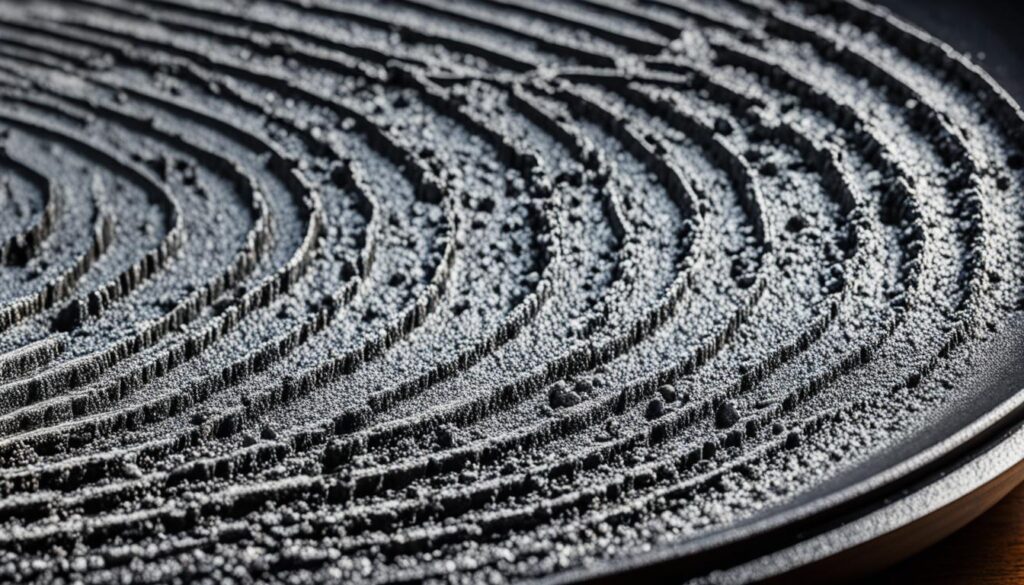
These skillets are almost all iron, about 97% to 98%. This iron content is why they heat up evenly and keep the heat well.
Next, the carbon in cast iron is vital. Carbon composes 2-4% of the mixture. It makes the iron a bit fragile but perfect for shaping. This shaping is what makes the skillets we use at home.
Silicon is also important, making up 1% to 3% of the alloy. It does two main jobs:
- Helps pour the iron smoothly into shapes
- Creates graphite for a good seasoning
Now, let’s break down their composition:
| Component | Percentage Range | Primary Function |
|---|---|---|
| Iron | 97-98% | Heat retention and distribution |
| Carbon | 2-4% | Allows for complex shaping |
| Silicon | 1-3% | Improves casting and seasoning |
This mix of materials ensures the skillet is tough and holds heat well. A 12-inch cast iron skillet usually weighs around 8 pounds. This weight helps it distribute heat evenly for perfect cooking. It’s why I trust mine for any recipe, knowing it will work well every time.
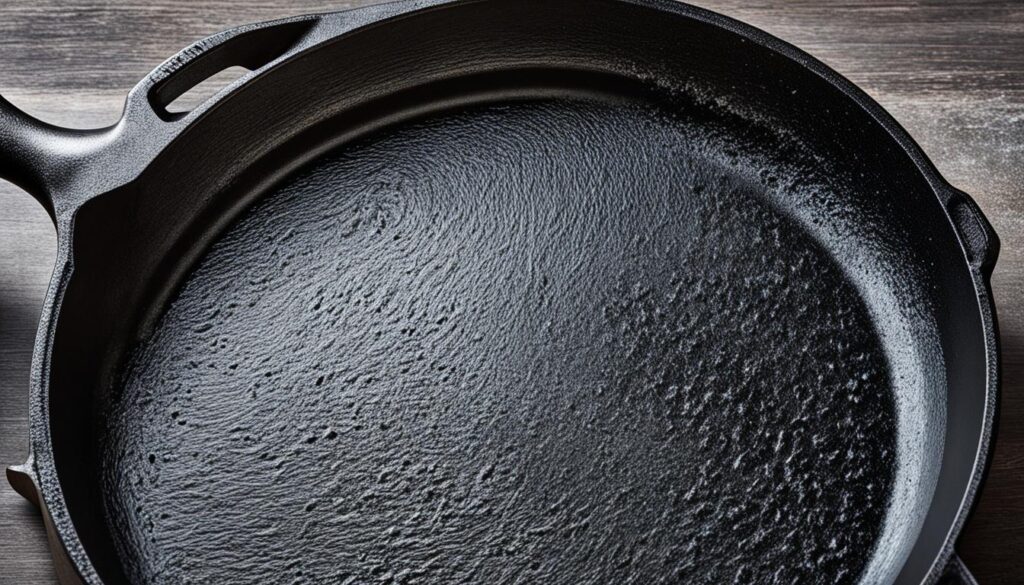
Alloys and Additives
Manufacturers add tiny bits of other elements to the base alloy. These extras enhance certain aspects of the skillet. For example, they include:
- Manganese: Makes the skillet harder and stronger
- Sulfur: Helps with shaping and machining
- Phosphorus: Aids in the casting process
Although used in small amounts, these additives are key to the skillet’s performance. They help it stay strong in high heat, perfect for cooking between 200°F to 460°F. This range makes it great for making quick and tasty stir-fry dishes.
Thanks to its iron blend, a cast iron skillet can naturally become non-stick when seasoned right. To season it, bake a thin layer of oil on the skillet at 350°F for an hour. It makes a sturdy cooking surface that gets better with every meal.
Knowing the ingredients of a cast iron skillet highlights why it’s a kitchen favorite. Its materials keep heat well, are very durable, and work for many types of cooking. It’s perfect for searing, frying, and baking all sorts of foods.
The Manufacturing Process of Cast Iron Skillets
Cast iron is made from raw materials, turning them into strong cookware. Here, I’ll explain how skillets are made with amazing detail.
Melting and Casting
Iron and other stuff get melted in a special furnace. This furnace is high-tech and makes sure everything is just right for making cast iron. When it’s good to go, the mix is ready for the next step.
Molding and Shaping
Molten iron goes into sand molds, thanks to a Disamatic machine. Getting the shape and size right is crucial in making skillets. Once they cool down, the castings are taken out of the molds.
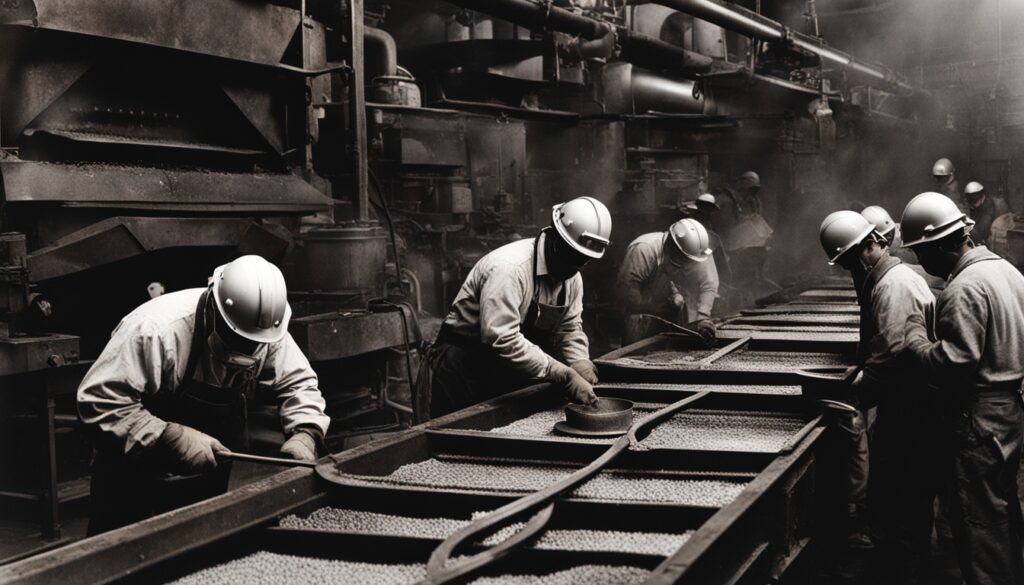
Finishing and Seasoning
Now, the castings are cleaned and scrubbed well. This gets rid of sand and makes them smooth. Finishing with seasoning makes a great cast iron skillet. And here’s how it’s done:
- Spray the skillet with vegetable oil
- Bake at high temperatures
- Allow to cool
- Repeat if necessary
Seasoning turns the skillet into a non-stick wonder. It also protects it from rust. Companies like Lodge Cast Iron really know what they’re doing after a hundred years.
Knowing how skillets are made makes me value them more. It’s a mix of old and new that gives us a classic kitchen item.
Unique Properties of Cast Iron Cookware
Cast iron skillets are popular in American kitchens. They are known for their ability to hold heat well, their long life, and being able to cook in many ways. This makes them special.
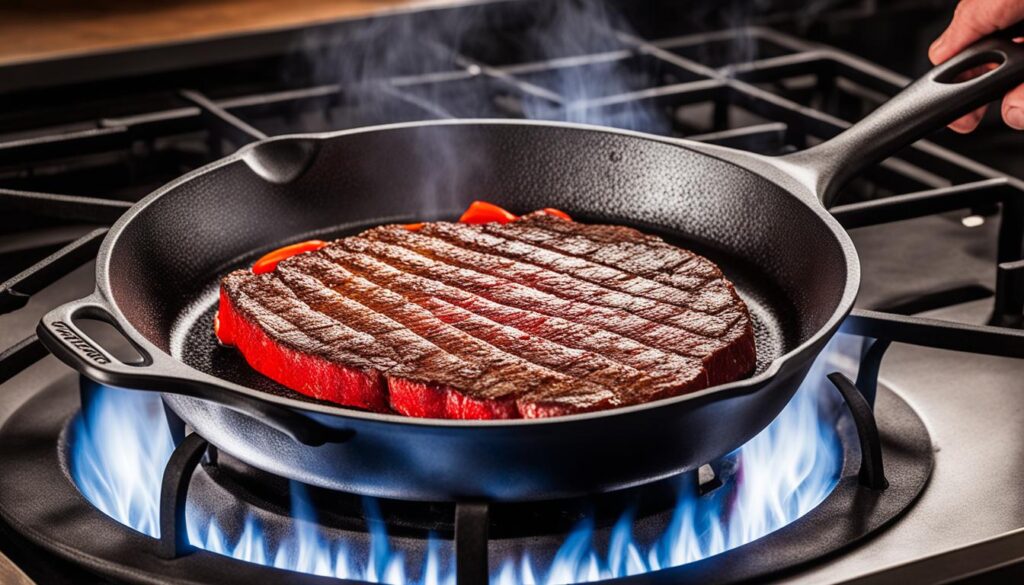
One key aspect of cast iron is how it keeps heat so well. When heated, these skillets stay hot. This is great for cooking steaks or making cornbread with a crispy edge. It also keeps the cooking temperature steady for dishes that need it.
Cast iron is also very strong and can last a long time with care. Families often hand down old cast iron pans. This shows just how durable they are.
These skillets are also very versatile. They can be used on the stove, in the oven, over a campfire, or on a grill. I enjoy using mine for a range of dishes like frying eggs and baking pizzas. Extra-large electric skillets can do a lot too, but there’s something special about cast iron.
| Property | Benefit |
|---|---|
| Heat Retention | Even cooking, great for searing |
| Durability | Lasts for generations with proper care |
| Versatility | Use on stovetop, oven, grill, or campfire |
However, modern electric skillets also have good features. The Oster CKSTSKFM05 16-Inch Electric Skillet, for example, lets you set the temperature precisely. It’s also light and has a non-stick surface. Yet, for those who love tradition and cooking on natural surfaces, cast iron is still the favorite.
- Naturally non-stick when properly seasoned
- Adds small amounts of dietary iron to food
- Improves with use over time
In conclusion, cast iron cookware brings a lot to the kitchen. Its heat control, lasting quality, and ways to cook make it a treasure. It provides a cooking experience that is fulfilling and never goes out of style.
Benefits of Cooking with Cast Iron
Cooking with cast iron has many pluses for my meals. I can make a variety of foods, from juicy steaks to sweet cornbread, all in the same skillet. Let’s look into why chefs and home cooks love these durable pans so much.
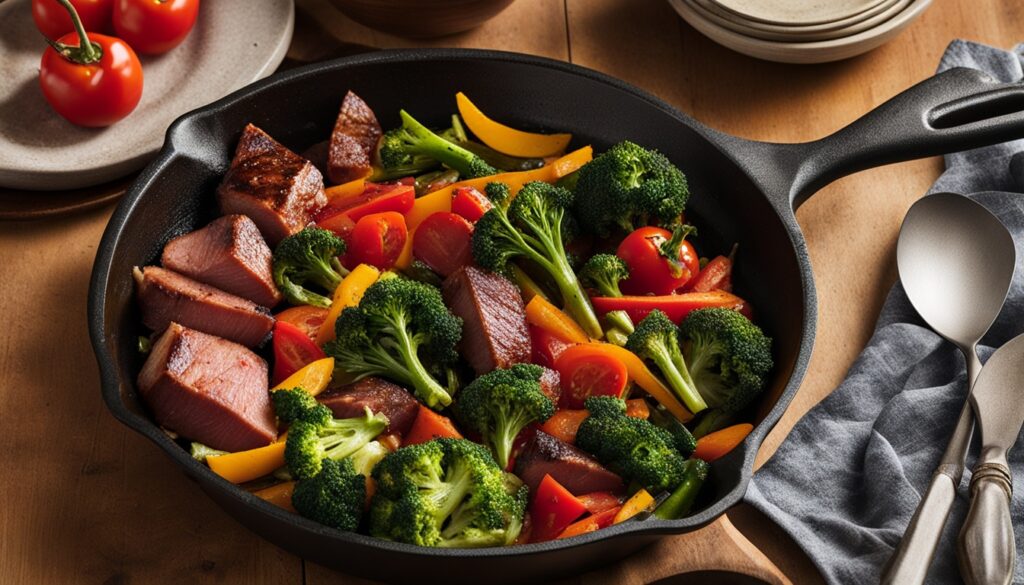
A seasoned cast iron skillet has a surface that’s almost like magic – it doesn’t stick. This happens naturally and means I can cook fragile foods easily. Plus, it’s a safer option than chemically treated pans and it improves with every meal cooked.
Food cooked in cast iron just tastes better. The seasoning in the pan infuses a special flavor into dishes. My cornbread and fried chicken are proof they come out with a delicious, richer taste.
Iron fortification is another big plus. Cooking in cast iron can add extra iron to your food. This is great news for anyone looking to up their iron levels naturally.
- Excellent heat retention and distribution
- Versatile for stovetop and oven use
- Durable and long-lasting
- Relatively inexpensive compared to other high-quality cookware
Cast iron skillets are really flexible. I can use them on the stove and then move them right into the oven. This makes them great for dishes that need long, slow cooking, like stewing or braising.
| Benefit | Description |
|---|---|
| Non-stick surface | Develops naturally with proper seasoning |
| Flavor enhancement | Adds depth and richness to dishes |
| Iron fortification | Increases iron content in food |
| Versatility | Suitable for stovetop and oven cooking |
Even with all these benefits, electric skillets with removable pans are getting more popular. They are easy to use and clean. But, for those of us who love the feel of traditional cooking and the unique taste of cast iron, these skillets are a must-have.
Caring for Your Cast Iron Skillet
Cast iron skillets can last for generations if you care for them right. I’ll show you how to keep your skillet like new for many years.
Proper Cleaning Techniques
The way you clean your skillet is both easy and important. First, rinse it with warm water. Then, use a stiff brush to scrub off any food bits. For tough spots, a scrub with a mix of kosher salt and water usually works. Remember, a bit of soap is okay here and there.
- Rinse with warm water
- Use a stiff brush or salt paste for scrubbing
- Dry thoroughly to prevent rust
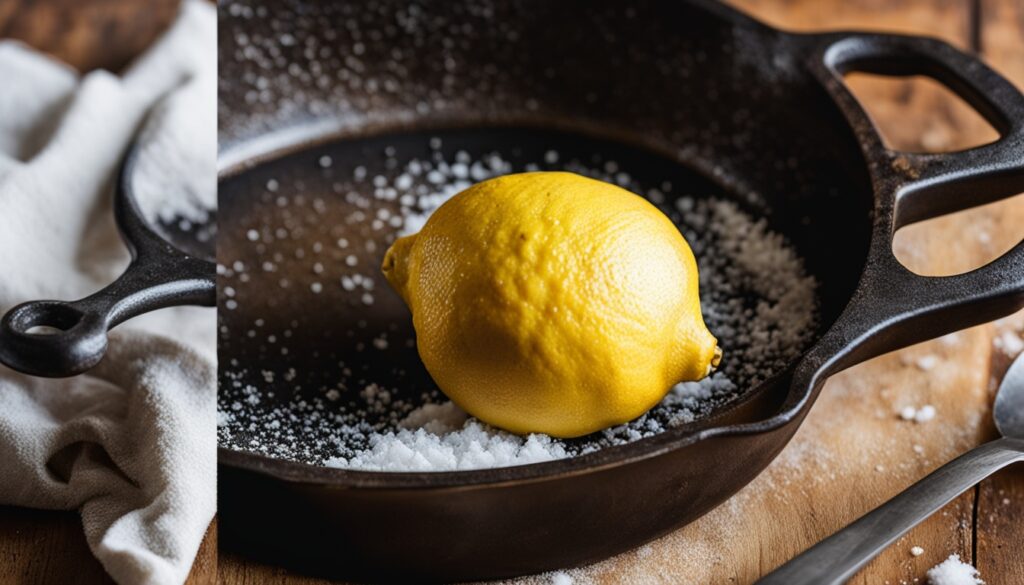
Seasoning and Maintenance
Seasoning your skillet is crucial for a non-stick surface. I coat mine with vegetable oil, inside and out. Next, I bake it at 450°F for an hour. This makes the skillet’s surface tougher with every use.
| Seasoning Step | Purpose |
|---|---|
| Apply thin oil layer | Creates base for non-stick surface |
| Bake at high temperature | Bonds oil to iron, forming polymer |
| Repeat process | Builds up seasoning layers |
Storing Your Cast Iron
Storing your skillet well is key. Always make sure it’s dry before putting it away. Placing a paper towel inside helps absorb any leftover moisture. Keep it in a dry spot, like a cupboard or oven, to maintain its great condition.
Follow these tips, and your skillet will be a go-to kitchen item, with a better, non-stick surface over time. A well-loved cast iron skillet is a kitchen hero that can last forever.
Enameled vs. Bare Cast Iron
In my research, I compared enameled and bare cast iron cookware. Both have unique benefits. But, they are different in ways that might affect your decision.
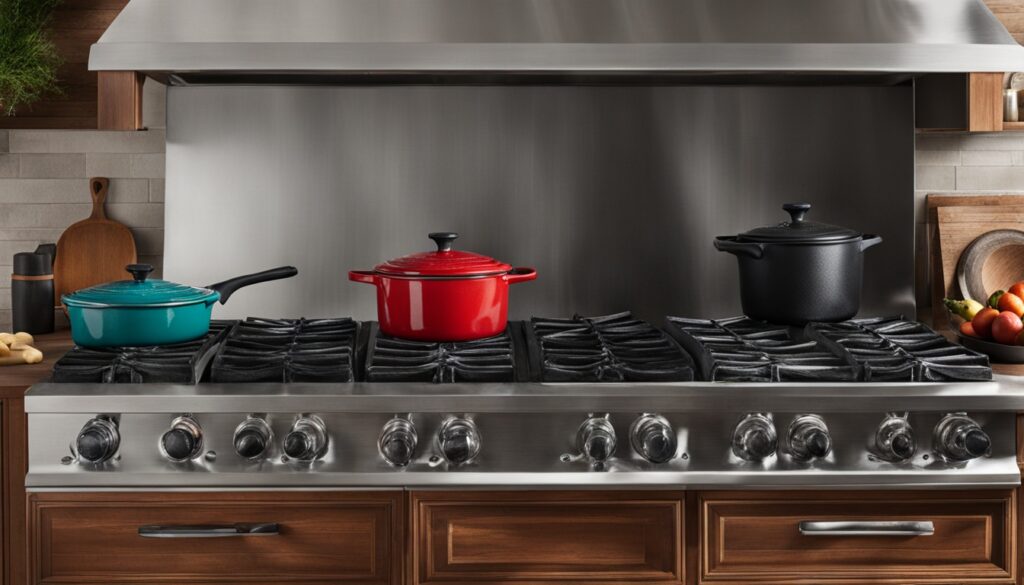
Bare cast iron skillets are best known for keeping heat well. They warm up slowly but keep an even heat, even with cold foods. These skillets are perfect for searing and become naturally non-stick if seasoned correctly.
Enameled cast iron, however, is easier to care for. The enamel stops the need for seasoning and makes cleaning simple. It’s also safe with acidic foods, unlike bare cast iron.
| Feature | Bare Cast Iron | Enameled Cast Iron |
|---|---|---|
| Price Range | $19 – $25 | $200 – $205 |
| Durability | Lifetime with proper care | Prone to chipping and cracking |
| Maintenance | Requires seasoning | No seasoning needed |
| Versatility | Grill, stovetop, oven | Stovetop, oven |
| Appearance | Classic black | Various colors available |
Bare cast iron is extremely durable. It rarely cracks or breaks, meaning it can last a lifetime. Enameled cast iron is durable too but can chip or crack easily if not careful.
For cooking, each type has its strengths. Bare cast iron is great for holding heat and searing. Enameled cast iron spreads heat more evenly, perfect for consistent cooking temperature.
- Bare cast iron is ideal for high-heat cooking and outdoor use
- Enameled cast iron excels in low to medium heat cooking and acidic dishes
- Bare cast iron requires more maintenance but offers better longevity
- Enameled cast iron is easier to clean but more expensive
Your pick between enameled and bare cast iron depends on how you cook, clean, and what you can spend. Both are key items for a great kitchen.
Health Considerations of Cast Iron Cooking
Cooking with cast iron can boost your iron intake as you make meals. Iron from the cookware can move into your food, giving you more dietary iron. This could be good news for some eaters.
Foods that are acidic, like tomato sauce or applesauce, pick up more iron. For example, a small serving of applesauce cooked in a cast iron skillet can go from 0.35 mg to 7.3 mg of iron. Also, the longer your food cooks, the more iron it can get.
This extra iron can help many people’s health. But, those with hemochromatosis should not use cast iron. It could bring in too much iron. For most, cooking with these pans is fine. It can be an easy way to get more iron in our diets, especially if we need it.
